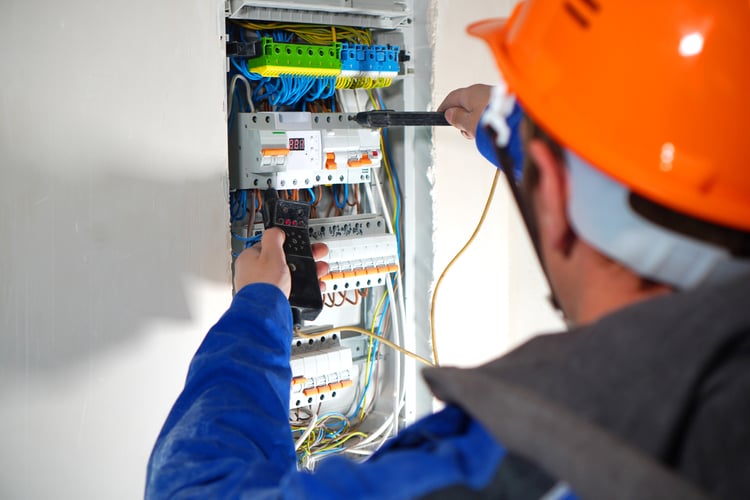Trust BRE Electrical Melbourne for High-Quality Electrical Services
Trust BRE Electrical Melbourne for High-Quality Electrical Services
Blog Article
The Ultimate Guide to Electrical Installation: Tips and Methods for a Safe and Reliable Home Electrical Wiring System
In the realm of home maintenance, couple of elements are as critical yet typically forgotten as the electrical circuitry system. Making certain a risk-free and effective home electrical wiring arrangement requires not just a fundamental understanding of electric concepts however additionally practical understanding of installment strategies and maintenance procedures. From browsing the intricacies of cord links to repairing common concerns that may arise, this overview intends to equip homeowners with the vital tips and devices needed for a secure and energy-efficient electric system. By discovering the subtleties of electric precaution and energy-saving techniques, this detailed overview will certainly clarify the complexities of home wiring, equipping individuals to take cost of their family's electric infrastructure.
Understanding Electrical Precaution
To guarantee the safety and security of both people and residential property, understanding and carrying out appropriate electric security measures is vital in any home circuitry project. It is crucial to conduct a thorough assessment of the electrical system prior to starting any kind of electrical wiring job to identify possible threats or concerns that need to be attended to.
Furthermore, using the suitable tools and devices is vital for maintaining safety during electric installations. Insulated handwear covers, voltage testers, and safety eyeglasses are a few of the standard safety gear that must be worn to stop electric shocks or accidents. It is likewise important to de-energize circuits before dealing with them and to identify all circuits and breakers plainly to stay clear of complication.

Essential Devices for Home Electrical Wiring
Making certain the appropriate execution of electric precaution in home circuitry tasks includes using a details collection of crucial tools made to help with the setup procedure successfully and safely. A few of the trick devices needed for home circuitry jobs consist of a voltage tester for inspecting online cables, wire pole dancers for eliminating insulation from cords, a cord cutter for precisely reducing wires to size, a screwdriver set for protecting electric elements, electrical tape for insulation and securing links, a cord ripper for stripping cable television sheathing, and a multimeter for determining voltage, present, and resistance. In addition, a drill with little bits is necessary for developing holes for circuitry and installing electric boxes, while fish tapes or rods help in drawing cables via conduits or walls. It is crucial to buy high-grade tools to guarantee accuracy, efficiency, and safety throughout home electrical wiring jobs. By having the necessary devices readily available, house owners can successfully navigate the installation process and preserve a secure electrical system within their homes - BRE Electrical Solutions.
Step-by-Step Electrical Installment Overview
Starting an electric installation task calls for meticulous preparation and adherence to safety standards. Before starting any work, guarantee you have BRE Electrical Solutions a thorough plan laying out the design of the electrical system, consisting of the placement of outlets, switches, and fixtures. Consider the power demands of each tool to establish the ideal cable gauge and circuit breaker sizes.
The initial step in the setup process is to shut off the power supply to the area where you will certainly be functioning. Make use of a voltage tester to confirm that the circuits are de-energized before touching any cords. Next, thoroughly get rid of existing fixtures or outlets and separate the wires.
When installing new electrical wiring, run wires with walls and ceilings, protecting them in location with ideal installations. Follow regional building codes and manufacturer guidelines for correct cable setup and links. BRE Electrical Solutions. See to it to label cables for simple identification and future upkeep

Troubleshooting Common Circuitry Issues
Having actually finished the installment procedure as detailed in the previous subtopic, troubleshooting common electrical wiring concerns is an essential skill for making certain the safety and capability of your electric system. One common problem is a stumbled circuit breaker, commonly caused by overloaded circuits or Going Here a short circuit. To repair this, find the breaker panel, determine the stumbled breaker by searching for the one not completely in the "on" setting, and reset it by turning it completely to "off" and then back to "on." One more prevalent issue is a damaged electrical outlet, defined by no power or periodic power supply. Make certain the electrical outlet is not managed by a switch, then utilize a voltage tester to look for power. If there is no power, switch off the circuit, evaluate the wiring links for any type of loosened or damaged wires, and replace the electrical outlet if needed. Continually flickering lights can indicate loosened electrical wiring links or an overloaded circuit. To address this, check and tighten up all cable links in the affected fixtures and buttons and redistribute the load on the circuit to balance the electrical demand. anchor On a regular basis inspecting and immediately addressing these typical electrical wiring issues will certainly keep the safety and efficiency of your home electric system.
Tips for Energy-saving Electrical Systems
For optimum energy effectiveness in electric systems, applying clever techniques and making use of energy-saving innovations is vital. One essential idea for accomplishing an energy-efficient electrical system is to update to LED lights. Proper insulation and sealing of windows, doors, and electrical outlets can also avoid power loss, eventually minimizing the workload on electric systems.
Conclusion
To conclude, applying proper safety procedures, utilizing necessary devices, complying with a detailed installment overview, fixing typical problems, and incorporating energy-efficient suggestions are crucial for a safe and effective home circuitry system. By adhering to these practices, property owners can make sure the durability and capability of their electric setups. It is very important to prioritize safety and efficiency when it comes to electrical operate in order to prevent prospective hazards and to maintain a reliable electric system in the home.
Report this page